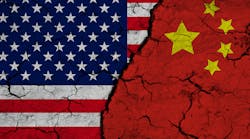The great pandemic-induced supply chain crash showed us that American manufacturing is woefully dependent on China. After the U.S. suffered through shortages of everything from pharmaceuticals to iPhones, there was much talk about decoupling, reshoring and making “made in America” profitable again.
But have we learned our lesson? No. We ricocheted right back. In 2022, U.S. imports of Chinese goods increased to $538.8 billion, just below the record set back in 2018. Though, to be fair, there was some positive change. A Deloitte survey found that 62% of manufacturers have started reshoring or nearshoring production. Overall, the U.S. is beginning to diversify imports, buying from more countries. And Congress also passed the CHIPS Act, a $280 billion industrial policy to boost the U.S. semiconductor industry and counter China.
The problem is, none of these advancements go fast or far enough to protect the industry, or consumers, if things fall apart with China in the short term. Imagine the impact of a prolonged conflict with the country that makes more things than any other country in the world. Since we depend on China for 90% of our antibiotics and the raw materials critical to make everything from smartphones to solar panels, we’d quickly be in trouble.
Of course, no one knows what’s going to happen, but every manufacturing leader should be preparing for the worst by doing five critically important things. Things that need to happen now – it’s too late once conflict erupts. If you still need convincing that investing in these five areas is the right strategy – they’re exactly the things manufacturers should be doing anyway to become more self-reliant and avoid future supply chain storms.
1. Remove China from the Center of the Supply Chain Web
Supply chains used to be like flow charts. Now they’re spiderwebs. And China is at the center.
During the supply snarls of the pandemic, some manufacturers were shocked at just how many of their raw materials or components – even those purchased in the U.S. – came from China or depended on Chinese parts. A conflict is no time for surprises. Know where every bolt and wire comes from and where each supply chain is most likely to fall apart. Scenario-plan for the worst-case scenario, have a Plan B for everything and perhaps begin to prudently stockpile essential raw materials.
Then go even further. Explore whether you can change your product design to reduce your dependency on China. Invest in more suppliers closer to home. And don’t put all your eggs in any other country’s basket. Few companies will be able to source everything domestically, but every company can explore “friendshoring”— building a network of trusted suppliers from friendly countries to reduce geopolitical risk.
It adds complexity to manage a less consolidated supplier base, but it will reduce disruption risk in the long run. Industry 4.0 technologies like IIoT, predictive analytics and machine learning can help manage your supply chain, balancing cost and risk.
2. Focus on Cyber Security
Even in peacetime, the FBI says China has conducted more cyber-attacks against the U.S. than all other major nations combined. One cyber-strike alone in 2021 stole possible trade secrets from 10,000 companies. As tensions escalate, it’s safe to assume these attacks will, too.
Smart factories are particularly vulnerable to disruption by bad actors because of digital operating systems. One major issue to watch is that in many factories, cybersecurity is focused on information technology (IT), not operating technology (OT) on the shop floor. Now is the time to make sure all the holes are plugged – integrate IT and OT, beef up network security and monitoring and improve threat detection. Future threats from China will be heavily reliant on cyber attacks against the very infrastructure manufacturers are rapidly adopting to compete with overseas production.
3. Bring Home Production
Remember when computer chip shortages eclipsed those of toilet paper part way through the pandemic? We couldn’t make $50,000 cars (or virtually any other modern technology for that matter) because we couldn’t get $1 chips. A conflict with China would be as impactful, only exponentially worse. Geopolitical experts predict trade would be rapidly swept off the seas, grinding American production to a halt, causing shortages and emergency rationing. The only way to avoid this is to bring home more production from China.
Globalism has largely been a good thing for manufacturing. Net-net it creates more prosperity to make things wherever it’s most economical to make them. But the disruption of the past few years has shown us the very real risks of being beholden to the ups and downs of foreign bedfellows. Take a good, hard look at your operations. What production could you begin reshoring today to reduce your global footprint? How could you nearshore production to less geopolitically risky places like Mexico? Reshoring is a long-term play, so it only helps if you start now, not after conflict erupts.
4. Use Advanced Technology to Build Resilience
We spent decades trimming the factory fat to maximize profits and efficiency. Everything has now been so optimized, it’s suboptimal. When chaos and disruption hit, there’s no padding, no extra inventory, no capacity. That’s why three years into the pandemic it can still take months to buy a car.
We desperately need a reset. No manufacturer wants to go back to the costly old days of warehouses full of stuff collecting dust. But it’s clear we need more flexibility in the system and more built-in surge capacity. Extreme cost optimization is out. Resilience is in. Investing in Industry 4.0 technology like cobots, automation and machine monitoring is the way to build that flex capacity. It can increase production two- or three-fold and fill the gaps in times of crisis, when we might be shut off from foreign suppliers. Investing in advanced technology today – even starting small – will help manufacturers be ready to respond to future supply chain disruption—in whatever form it takes.
5. Prepare to Pivot Production
If a conflict breaks out, the government could go into your factory tomorrow and tell you what to make and how much to sell it for. They can even do that during peacetime in the interest of homeland security. In fact, during the pandemic, the U.S. government used the Defense Production Act 18 times to aid vaccine development. This Korean War era law allows the president to prioritize defense production, set price ceilings and allocate "materials, services, and facilities.” It’s a daunting notion. But the good news is we already know how to do this. During the pandemic, hundreds of American manufacturers voluntarily pivoted production to help make medical supplies. In Ohio alone, we made 50 million pieces of personal protective equipment in just a few months.
Mattress makers made masks. Toy makers made plastic shields. Distilleries made hand sanitizer. And here’s what we learned. Technology makes it easier and faster to reconfigure your factory. Cross-training staff gives you a much more flexible workforce. And the more innovative the company, the more agile and creative it will be when disruption hits. The companies who had all three of these things survived the pandemic much better. And that’s exactly where manufacturers need to invest now to be ready to survive a war (or pivot production during the next peacetime supply chain crisis).
No matter what the future brings – with China or anything else – making advances in these five areas will help manufacturers be less vulnerable, more resilient, and much better at navigating whatever chaos lies ahead.
Ethan Karp is president & CEO, MAGNET (the Manufacturing and Growth Network), an Ohio Manufacturing Extension Partnership.




